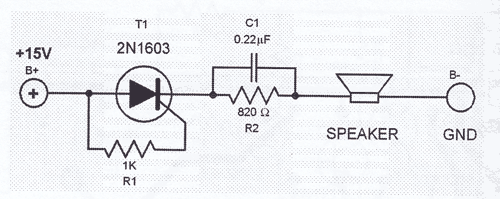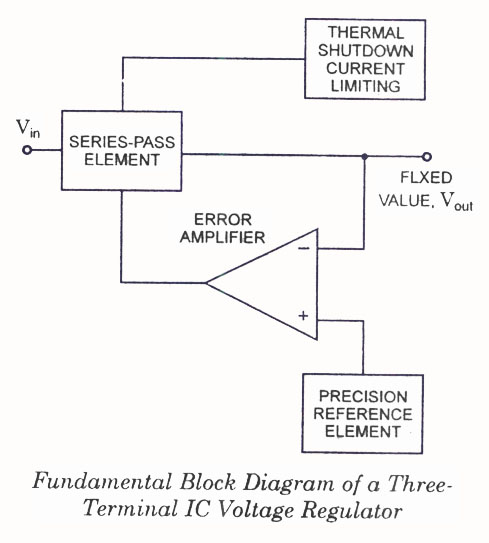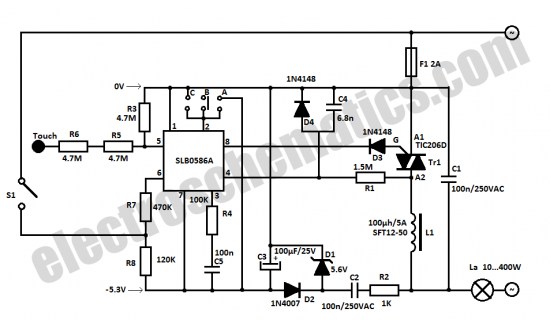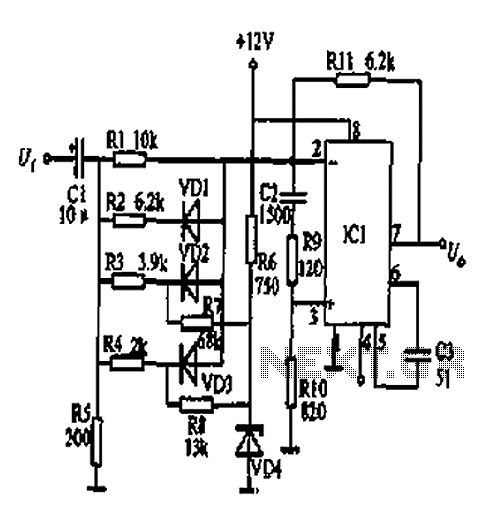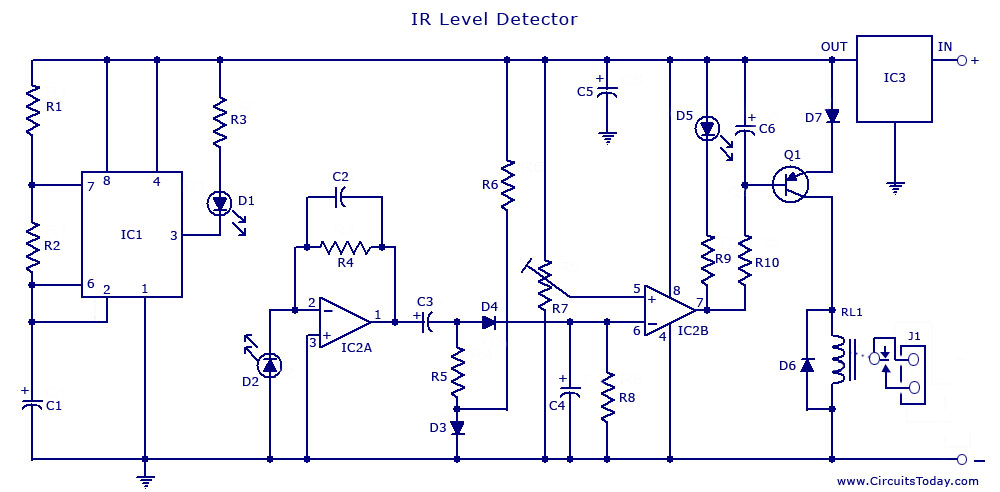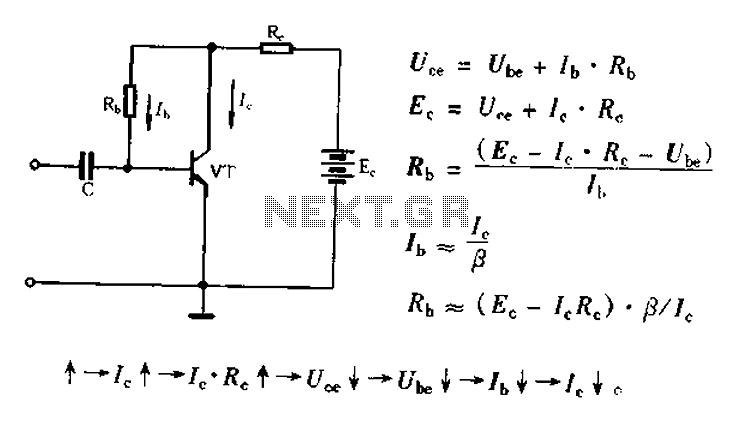
DAC0832 single - bipolar voltage output interface circuit
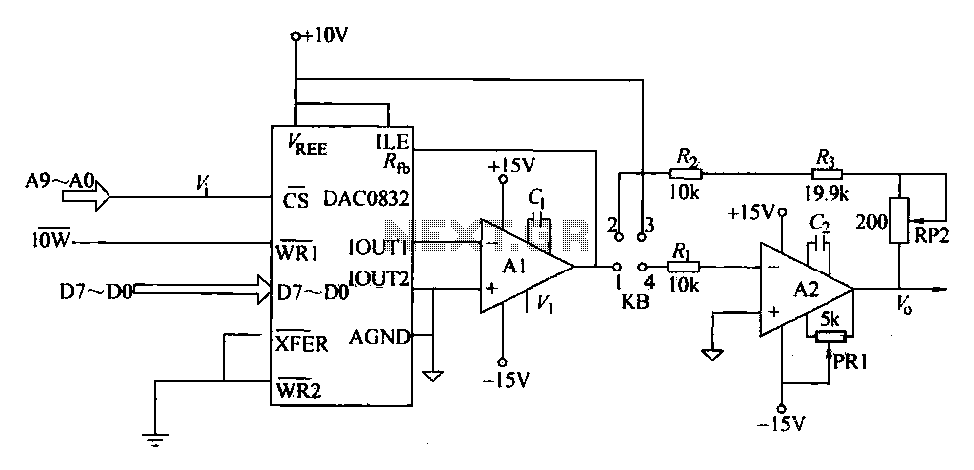
The DAC0832 is a digital-to-analog converter (DAC) chip designed for integration with computer bus systems. It features an 8-bit resolution and operates with a single power supply ranging from 5 to 15 volts. The device is compatible with TTL logic levels. The DAC's output can be classified into two types: unipolar and bipolar. The unipolar output provides a voltage range of 0 to 10 volts DC, while the bipolar output offers a range from -10 volts to +10 volts DC. The interface circuit for the DAC0832, including connections for data input and control signals, is illustrated in Figure 27-11. Control signals XFER and WR2 are grounded, while the ILE signal is set high. Additionally, a shorting column labeled KB can be configured to select between unipolar and bipolar output modes.
The DAC0832 is a versatile 8-bit digital-to-analog converter that facilitates the conversion of digital signals into corresponding analog voltages. It is particularly suited for applications requiring straightforward integration with microcontrollers and computer systems due to its TTL compatibility and simple interfacing capabilities.
The device operates on a single power supply, simplifying the design and reducing the number of required components. The input levels are compatible with standard TTL logic, making it easy to connect to digital systems without additional signal conditioning.
The output configuration of the DAC0832 is flexible, allowing for both unipolar and bipolar voltage outputs. In unipolar mode, the output voltage ranges from 0 to 10 volts DC, which is suitable for many applications that require a positive voltage output. To configure the DAC for unipolar operation, short connections are made between specific pins, namely KB1-4 and KB2-3.
In bipolar mode, the DAC0832 can output voltages ranging from -10 volts to +10 volts DC. This mode is beneficial in applications where both positive and negative voltages are required. The configuration for bipolar output is achieved by appropriately shorting the KB connections, ensuring that the device operates within the desired voltage range.
The interface circuit for the DAC0832 includes connections for data input and control signals, which are critical for its operation. The XFER and WR2 control signals are grounded, indicating that they are inactive during standard operation. The ILE signal, when set high, enables the internal logic of the DAC to process incoming digital data.
In summary, the DAC0832 is a highly functional and adaptable digital-to-analog converter capable of meeting the needs of various electronic applications, from simple signal generation to more complex systems requiring precise analog outputs. Its ease of integration, coupled with the ability to select between unipolar and bipolar outputs, makes it a valuable component in the design of electronic circuits.DAC0832 is a memory device having two input engrave a D/A converter chip, can be connected directly to the computer bus. Its main properties are as follows: 8-bit resolution; s ingle power supply (5-15v) i input level and TTL logic level compatible. D/A converter circuit output current and voltage outputs are divided into two kinds. Unipolar output voltage bipolar fork into two, as shown in Figure 27-11 DAC0832 interface circuit for the single/bipolar voltage output is shown. Figure, DAC0832 data input and computer system data bus. XFER, WR2 control signals are grounded, ILE pick high. Short column KB short of 1-z when connected. Compared with unipolar voltage (O-lOV DC) output; KB of l-4 and 2-3 short-circuited, for the dual polarity (-10V-O- + 10V DC) output,
The DAC0832 is a versatile 8-bit digital-to-analog converter that facilitates the conversion of digital signals into corresponding analog voltages. It is particularly suited for applications requiring straightforward integration with microcontrollers and computer systems due to its TTL compatibility and simple interfacing capabilities.
The device operates on a single power supply, simplifying the design and reducing the number of required components. The input levels are compatible with standard TTL logic, making it easy to connect to digital systems without additional signal conditioning.
The output configuration of the DAC0832 is flexible, allowing for both unipolar and bipolar voltage outputs. In unipolar mode, the output voltage ranges from 0 to 10 volts DC, which is suitable for many applications that require a positive voltage output. To configure the DAC for unipolar operation, short connections are made between specific pins, namely KB1-4 and KB2-3.
In bipolar mode, the DAC0832 can output voltages ranging from -10 volts to +10 volts DC. This mode is beneficial in applications where both positive and negative voltages are required. The configuration for bipolar output is achieved by appropriately shorting the KB connections, ensuring that the device operates within the desired voltage range.
The interface circuit for the DAC0832 includes connections for data input and control signals, which are critical for its operation. The XFER and WR2 control signals are grounded, indicating that they are inactive during standard operation. The ILE signal, when set high, enables the internal logic of the DAC to process incoming digital data.
In summary, the DAC0832 is a highly functional and adaptable digital-to-analog converter capable of meeting the needs of various electronic applications, from simple signal generation to more complex systems requiring precise analog outputs. Its ease of integration, coupled with the ability to select between unipolar and bipolar outputs, makes it a valuable component in the design of electronic circuits.DAC0832 is a memory device having two input engrave a D/A converter chip, can be connected directly to the computer bus. Its main properties are as follows: 8-bit resolution; s ingle power supply (5-15v) i input level and TTL logic level compatible. D/A converter circuit output current and voltage outputs are divided into two kinds. Unipolar output voltage bipolar fork into two, as shown in Figure 27-11 DAC0832 interface circuit for the single/bipolar voltage output is shown. Figure, DAC0832 data input and computer system data bus. XFER, WR2 control signals are grounded, ILE pick high. Short column KB short of 1-z when connected. Compared with unipolar voltage (O-lOV DC) output; KB of l-4 and 2-3 short-circuited, for the dual polarity (-10V-O- + 10V DC) output,
